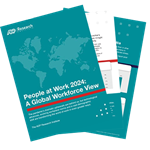Today, we're lifting the lid on some of the most intriguing findings from our latest study, People at Work 2024: A Global Workforce View.
The world at work has changed immensely over recent years, and much of it for the good. Our findings show that men and women are similarly appreciative of employers’ efforts at improving diversity and inclusion over the last few years (45% of men/47% of women say their firm has got better at this).
But beneath this seeming symmetry of views, the nuances of our study results tell a different story. Men trail women on several key predictors of work satisfaction, productivity and engagement.
Read on as we unpack the main takeaways for HR leaders.
Men’s wellbeing at work — is pay the problem?
When it comes to what men and women value in their jobs, on aspects like job security, career progression and enjoyment of a day’s work there’s barely a hair between them.
The gaps start to show when we look at the work satisfaction ratings, however.
While 73% of women say they’re satisfied in their roles, fewer men (68%) say the same. Asked to single out the reason for their dissatisfaction, more men (15%) than women (11%) cite ‘incorrect or often late pay’ as the root cause.
In fact, dissatisfaction around pay seems to be at the heart of the issue for many men in the global working population. Men are less likely than women to:
- think their pay is fair for the work they do (69% women, 65% men)
- say they’re paid fairly for their role and responsibilities (68% women, 64% men)
- agree they have easy access to their pay information online (75% women, 72% men).
At the same time, more men than women believe they’re underpaid for their job.
This sense of not being rewarded fairly extends to other forms of appreciation at work. Fewer men (68%) say they receive the recognition they want for their work than women (73%), with the same percentages saying they feel "noticed and recognised for their contributions.”
How can HR leaders respond?
Incoming pay transparency legislation in many countries could provide the impetus to help you shine a light on any gender disparity in compensation across your organisation. To achieve pay transparency, HR teams first need company-wide data transparency. Analytics such as those provided by ADP can help you quantify pay gaps by gender and ethnicity, and estimate the costs to close them.
Men less positive about career prospects
Across a range of industries, our study finds that men are less likely than women to:
- be happy with how their career is progressing (61% men, 66% women)
- say their employer talks to them about career progression (61% men, 66% women)
- report that their employer is investing in the skills they’ll need to make headway in their careers (45% men, 50% women).
So it’s perhaps not surprising that men are less optimistic than women about their career prospects and the skills they’ll need to get ahead. While 61% of women think they have the skills required to take their career to the next job level in the next three years, men (58%) are slightly less upbeat.
Some of this doubt may be wrapped up in feelings about how AI is set to affect ways of working. Our findings shows subtle differences in men's and women’s responses:
- More men think AI will replace most of what they currently do at work (14% men, 12% women)
- Fewer men believe AI is going to help them save time on a daily basis (18% men, 20% women)
- Men are less likely to admit they don’t know enough about AI to say what role it will have on their jobs (6% men, 8% women)
Though the differences on the AI topic are currently small, it will be interesting to see how men’s and women’s attitudes develop and possibly diverge in the years to come. It’s certainly one for HR leaders to keep an eye on.
Men’s mental health at work
Although firms have made strides in fostering environments where employees feel physically safe, there’s more to do on the mental health front. Men in our study report feeling their work is suffering due to poor mental health, and more men (37%) than women (32%) say they take an excessive number of breaks because they’re stressed at work.
It’s clear that men feel relatively unsupported in the workplace whether by fellow workers or their own managers:
- Fewer men (64%) than women (69%) feel their colleagues support their mental health
- Fewer men (58%) than women (64%) feel their managers support their mental health
- Overall, fewer men (61%) than women (67%) say that their employer supports their mental wellbeing
Only 58% of men are satisfied with the mental wellbeing support their employer provides (compared to 64% of women)
How can HR leaders respond?
This is a signal for HR leaders to bolster efforts in creating support systems that recognise and tackle the mental health challenges that men face. Such action would help level out the proportion of employees who say they feel able to have open conversations about their mental health at work (where women, at 65%, currently lead men by four percentage points).
Men’s physical health at work
We mentioned the progress that companies have made in improving health and safety in the physical working environment. But here, too, the results from men give some pause for thought.
If you’re male, you’re less likely to:
- feel physically safe at work (75% men, 81% women)
- be satisfied with your workplace’s physical layout (70% men, 74% women)
- have an employer who takes appropriate health and safety measures (72% men, 76% women).
Taken in the context of the other findings we highlight in this article, this is further evidence that men’s wellbeing in the workplace should be high up on the HR agenda.
Is flexible working really working for men?
Finally, let’s look at our research results on flexible working – a topic that’s often associated with women’s wellbeing and needs more than men’s.
Globally, men are more likely than women to have two or three sources of income (such as extra jobs) and we’ve observed an interesting phenomenon around men’s need for flexibility as the underlying reason for these multiple income streams.
Through the ages of 25-54 (for many employees, the childrearing years), women are more likely than men to say the need for better work-life balance is the reason they’re working more than one job. But across the other age ranges, it’s men who say that greater flexibility is the motivation for that extra source of income.
“Flexibility/work-life balance is the reason I have more than one source of income”
| Men | Women | |
|---|---|---|
|
Aged 18-24 |
14% |
8% |
|
Aged 25-34 |
12% |
20% |
|
Aged 35-44 |
16% |
19% |
|
Aged 45-54 |
14% |
15% |
|
Aged 55> |
18% |
11% |
Yet men are less satisfied than women with the flexibility their employers provide in terms of working hours and location (in both cases by around five percentage points).
On top of that:
- Men are less likely than women to feel empowered to take advantage of flexible working arrangements (men 66%, women 70%)
- Fewer men (59%) than women (64%) are offered job-sharing opportunities
- In every country we surveyed (except for China and Japan), men work more hours of unpaid overtime per week than women
How can HR leaders respond?
One thing is to offer flexible working opportunities, another is to ensure employees are encouraged to take advantage of these. Start by reading our article on the factors that influence employers’ provision of flexible working. This will help you analyse the equality of the employee experience your firm offers.
Discover more thought-provoking topics from
ADP’s People at Work 2024 global survey


